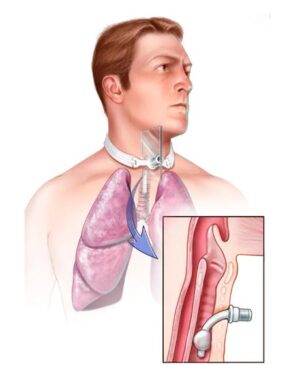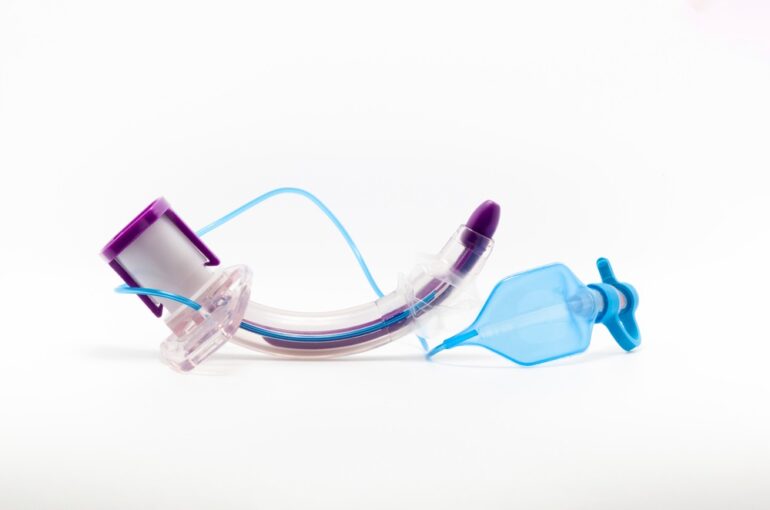Various health conditions demand respiratory aid for the patient as they render it hard for them to breathe. Keeping this in mind, multiple breathing assisting devices have been designed, manufactured, and marketed, among which are tracheostomy tubes. Putting these tubes into the trachea is called a tracheostomy.
What is a tracheostomy?
Tracheostomy is a surgical procedure conducted to make an opening, called a stoma, into the patient’s trachea or windpipe with the aim to insert a tracheostomy tube through it for respiratory assistance. It was first proposed by Greek physicians thus the name literally means a hole into the windpipe’, trachea meaning windpipe, and stoma meaning the hole or cutting.


Tracheostomy tube was inserted and fixed into the tracheal tube
Tracheostomy vs tracheotomy
A closely related term to tracheostomy is ‘tracheotomy’. Although a slight difference does exist between the two terminologies, both a frequently used in a simultaneous manner. As per the definition, the process of making a hole into the trachea is tracheotomy while the hole itself is referred to as tracheostomy. Minimizing the confusion, both terms are considered the same and are thus used interchangeably.
Types of tracheostomy
Depending upon the site where the tracheostomy is being conducted, it can be classified into three types:
- High tracheostomy: High tracheostomy is done above the thyroid gland by 2 cm. Precisely, its location is near the first ring of the trachea.
- Mid tracheostomy: The location of the mid tracheostomy is near the second or third ring of the tracheal pipe or near the isthmus region of the thyroid gland.
- Low tracheostomy: Low tracheostomy is performed at the fourth ring of the tracheal tube just below the isthmus region.
In addition to this classification, the tracheostomy can also be classified into two categories based on its time duration. These include:
- Temporary tracheostomy: In this case, the tracheostomy tube is put into the windpipe for a short and definite period of time. Once its job is done, the tube is removed.
- Permanent tracheostomy: In other cases, the tracheostomy tube can also be put into the patient’s tracheal tube for an indefinite period of time.
Uses/Applications of tracheostomy
The process of tracheostomy is advantageous in patients who are suffering from any of the following conditions:
- Blockage in the trachea
- Extremely small-sized trachea
- Anaphylactic shock i.e. severe allergic reaction
- Subglottic web i.e. constriction of the airway passage below the vocal cords due to the fibrous tissue membrane
- Cystic hygroma i.e. congenital appearance of a sac-like structure between the head and neck region
- Treacher Collins syndrome i.e. genetic disorder affecting the facial development
- Pierre Robin syndrome i.e. genetic disorder causing an underdeveloped jaw along with improper placement of the tongue
- Oral, neck, or brain cancers
- An injury in the larynx
- Congenital or birth defects in the trachea
- Burning of the tracheal lining due to the inhalation of corrosive chemical agents
- Unconsciousness or coma

Process of inhalation and exhalation via a tracheostomy tube
- Bronchopulmonary dysplasia (BPD) i.e. congenital defects in the airway passage in newborns
- Vocal cords paralysis
- Laryngeal spasm
- Laryngeal injury
- Facial burns
- Facial surgery
- Aspiration i.e. tracheal problems due to the inhalation of food or liquids
- Severe respiratory infections
- Critical illness due to lung diseases
- Nocturnal breathing difficulties i.e. sleep apnea
- Excessive mucus production in the tracheal tube
- Breathing dependency on a ventilator
In all of the above mentioned conditions, the tracheostomy is performed for one of the following reasons:
- To assist in the breathing process
- To remove the secretions from the respiratory tract
- To end the patient’s dependency on a ventilator
Risks associated with tracheostomy
Tracheostomy, like all other surgical procedures, is not free from risks. The following complications can be experienced by the patients after the tracheostomy is done:
- Tracheal bleeding and trauma
- Esophageal trauma followed by scarring
- Tracheal or respiratory infection
- Accidental decannulation i.e. accidental removal of the tracheostomy tube
- Pneumonia
- Pneumothorax i.e. entrapment of air around the lungs
- Pneumomediastinum i.e. entrapment of air in the deeper chest tissue
- Subcutaneous emphysema i.e. entrapment of air under the skin near the tracheostomy tube
- Laryngeal nerve damage
- Tracheomalacia i.e. thinning of the windpipe due to the prolonged use of tracheostomy tube
- The appearance of granulation tissue in the windpipe
- Development of trachea-esophageal fistula i.e. an opening between the tracheal pipe and esophageal tube
- The collapse of the tracheal tube
Precautionary measures
The following precautionary measures should be taken while a tracheostomy tube is administered to a patient:
- After a tracheostomy procedure, care should be taken in terms of cleaning the stoma. For this purpose, the use of clean gauze with a saline solution is recommended. Any clotted blood, crust, or dried mucus should be removed carefully.
- The skin near the tracheostomy tube must be kept dry. A waterproof covering should be used while taking a shower.
- Replacement of the tracheostomy tube after a certain period is also recommended.
- The patient or anyone other than a healthcare professional should avoid trying to replace or remove the tracheostomy tube.
Cost of a tracheostomy process
The cost of a single tracheostomy tube lies between $50 to $250. However, the tracheostomy itself costs between $3672 to $6385 depending upon the type of the procedure and the patient’s condition.
Conclusion
Among many options used for providing respiratory aid to patients with breathing difficulties, tracheostomy is one of the most frequently used options. It is a minimally invasive process where a tracheostomy tube can be fixed into the windpipe via a small hole made by incising the trachea. The process helps clean the trachea from the fluids, assists the supply of oxygen, and provides long-term as well as short-term breathing support. Hence, tracheostomy is one of the easy and cost-friendly medical procedures.

PhD Scholar (Pharmaceutics), MPhil (Pharmaceutics), Pharm D, B. Sc.
Uzma Zafar is a dedicated and highly motivated pharmaceutical professional currently pursuing her PhD in Pharmaceutics at the Punjab University College of Pharmacy, University of the Punjab. With a comprehensive academic and research background, Uzma has consistently excelled in her studies, securing first division throughout her educational journey.
Uzma’s passion for the pharmaceutical field is evident from her active engagement during her Doctor of Pharmacy (Pharm.D) program, where she not only mastered industrial techniques and clinical case studies but also delved into marketing strategies and management skills.
Throughout her career, Uzma has actively contributed to the pharmaceutical sciences, with specific research on suspension formulation and Hepatitis C risk factors and side effects. Additionally, Uzma has lent her expertise to review and fact-check articles for the Health Supply 770 blog, ensuring the accuracy and reliability of the information presented.
As she continues her PhD, expected to complete in 2025, Uzma is eager to contribute further to the field by combining her deep knowledge of pharmaceutics with real-world applications to meet global professional standards and challenges.








